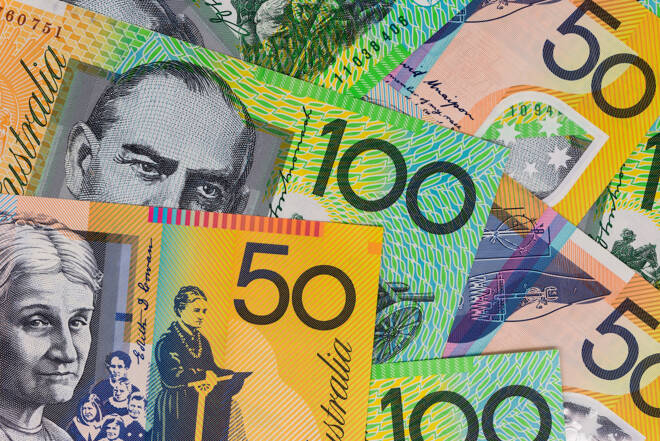Advertisement
Advertisement
AUD/USD Forecast: Australian GDP, US Labor Market, and Fed’s Powell – Key Influences
By:
Key Points:
- The AUD/USD fell by 0.06% on Tuesday, ending the session at $0.65038.
- On Wednesday, Q4 GDP numbers from Australia and the NPC will be focal points.
- Later in the session, the US economic calendar will need consideration, with Fed Chair Powell taking center stage.
Tuesday Overview of the AUD/USD
The AUD/USD fell by 0.06%. Following a 0.22% decline on Monday, the Australian dollar ended the session at $0.65038. The Australian dollar fell to a low of $0.64772 before rising to a high of $0.65208.
The Australian Economy and NPC in the Spotlight
On Wednesday, the Australian economy will come under the spotlight. Q4 GDP numbers will garner investor interest. Economists forecast the Australian economy to expand by 0.3% quarter-on-quarter after growing by 0.2% in Q3.
Economists expect the economy to grow by 1.4% year-on-year after expanding by 2.1% in Q3.
Weaker-than-expected numbers could fuel bets on an H1 2024 RBA rate cut. Investors must consider private consumption. Household spending is a focal point for the RBA. Weaker private consumption could dampen demand-driven inflationary pressures and allow the RBA to cut rates.
Finalized retail sales figures for January are also out. A revision to preliminary figures would need consideration. According to the preliminary report, retail sales increased by 1.1% in January after sliding by 2.1% in December.
Beyond the numbers, National People’s Congress (NPC)-related news warrants investor attention. Support for the property sector and discussions about a fiscal stimulus package would move the dial.
A fiscal stimulus plan may amplify demand from China, constituting approximately one-third of Australian exports. The Australian trade-to-GDP ratio surpasses 50%, with around 20% of the workforce engaged in trade-related occupations.
An improving macroeconomic environment could bolster the Australian labor market and support wage growth. Upward trends in wage growth could raise disposable income and fuel consumer spending and demand-driven inflation. The net effect may be a delay to RBA plans to cut interest rates.
US Economic Calendar: Labor Market and Fed Chair Powell in Focus
ADP employment change and JOLTs Job Openings will warrant investor attention on Wednesday. The ISM Services PMI for February signaled a decline in service sector jobs. Weaker-than-expected numbers could fuel bets on a June Fed rate cut and fear of a hard landing.
A softer labor market may impact wage growth and disposable income. Downward trends in disposable income and labor market uncertainty could curb consumer spending.
Economists forecast the ADP to report a 150k increase in employment in February, up from 107k in December. However, economists expect JOLTs Job Openings to fall from 9.026 million to 8.900 million in January. Investors must also consider quit rates. Workers are less likely to leave their jobs in a deteriorating labor market environment.
While the numbers will influence the buyer appetite for the AUD/USD, Fed Chair Powell will have the final say. The Fed Chair will give testimony on Capitol Hill. Inflation, the economic outlook, and timelines for interest rate cuts will garner investor interest.
Short-Term Forecast
Near-term AUD/USD trends will hinge on Australian GDP numbers, US labor market data, and Fed Chair Powell. A tighter US labor market, a hawkish Fed Chair, and weaker Australian economic growth would impact the AUD/USD. However, updates from the NPC also need consideration.
AUD/USD Price Action
Daily Chart
The AUD/USD hovered below the 50-day and 200-day EMAs, affirming bearish price signals.
An Aussie dollar move to the $0.65500 handle and the 50-day would give the bulls a run at the 200-day EMA. A breakout from the 200-day EMA would bring the $0.66162 resistance level into play.
NPC-related news, Q4 GDP numbers from Australia, US labor market data, and Fed Chair Powell need consideration.
However, a break below the $0.64900 support level could signal a drop to the trend line and the $0.63853 support level.
A 14-period Daily RSI reading of 42.39 suggests an AUD/USD fall to the trend line before entering oversold territory.
4-Hourly Chart
The AUD/USD remained below the 50-day and 200-day EMAs, confirming the bearish price trends.
An AUD/USD breakout from the 50-day would bring the 200-day EMA and $0.65500 handle into play.
On the other hand, a break below the $0.64900 support level could give the bears a run at the trend line and the $0.63853 support level.
The 14-period 4-Hourly RSI at 46.60 suggests an AUD/USD fall through the $0.64500 handle before entering oversold territory.
About the Author
Bob Masonauthor
With over 28 years of experience in the financial industry, Bob has worked with various global rating agencies and multinational banks. Currently he is covering currencies, commodities, alternative asset classes and global equities, focusing mostly on European and Asian markets.
Advertisement
